The audio for this virtual presentation is a portion of what is available on our museum’s Audio Tour Guides. We thank longtime Williamsport radio personality Lou Kolb for providing the main narration.
The recordings below were created for hand-held audio players. Since you can access these recordings simply by pressing play on your own device, there’s no need to enter any numbers in order to hear each presentation.
FIRST INNING
Viewing Plaza
Audio Player
Welcome to the first inning of your outdoor tour of the Little League International complex. To start your orientation, please stand near the first-inning interpretive panel, and face downhill. This first panel is located at the east end of the World of Little League Museum parking lot, near the Flag Plaza. (Please note: This complex is private property. While visiting this complex, you must obey all signage, and you are not permitted to enter any buildings.)

As you already know, the building to the left of this interpretive panel is the World of Little League Museum and Official Store. The museum is where you’ll find hundreds of unique exhibits and artifacts, and where anyone of any age can have lots of interactive fun.
The museum, originally opened in 1982, was named to honor the late Peter J. McGovern, who was the first full-time President of Little League. A 3-year project to completely renovate the museum was completed in June of 2013.
Farther to the left, toward the west across Fairmont Avenue, is a smaller brick building. That’s the John W. Lundy Little League Conference Center. It’s used for meetings and seminars throughout the year.
The Lundy Center, completed in 1996, is named for the late John W. “Jack” Lundy, who was the owner of Lundy Lumber, one of the first three sponsors of Little League, in 1939. He served as a member of the Little League International Board of Directors for nearly 20 years.
To your immediate right is the viewing plaza. Along the first base line are the flags of the countries in the international pool of the Little League Baseball World Series. From left to right while standing at the pitcher’s mound, they are in alphabetical order.

The flags of the U.S. States in the series are on the third base line. Left to right from the pitcher’s mound, they are in the order in which they were admitted to the union.
Every year, as each new team is determined for the upcoming world series, the flags are lowered and raised accordingly. The flags of the United States and Pennsylvania, just behind home plate, are permanent.
This plaza was made possible thanks to the generosity of the First Community Foundation Partnership of Pennsylvania. The Foundation has a history of assisting with projects here at Little League International going back to the 1950s.
Now let’s move on to the second inning. Don’t go downhill just yet, however. Instead, use the sidewalk behind home plate, and head toward the large brick building to the right. That’s the Administration Building – identified by the sign near the road.
The next interpretive panel is near the entrance to this building.
SECOND INNING
Administration Building
Audio Player
By now, you should be near the entrance to the Administration Building of Little League International.
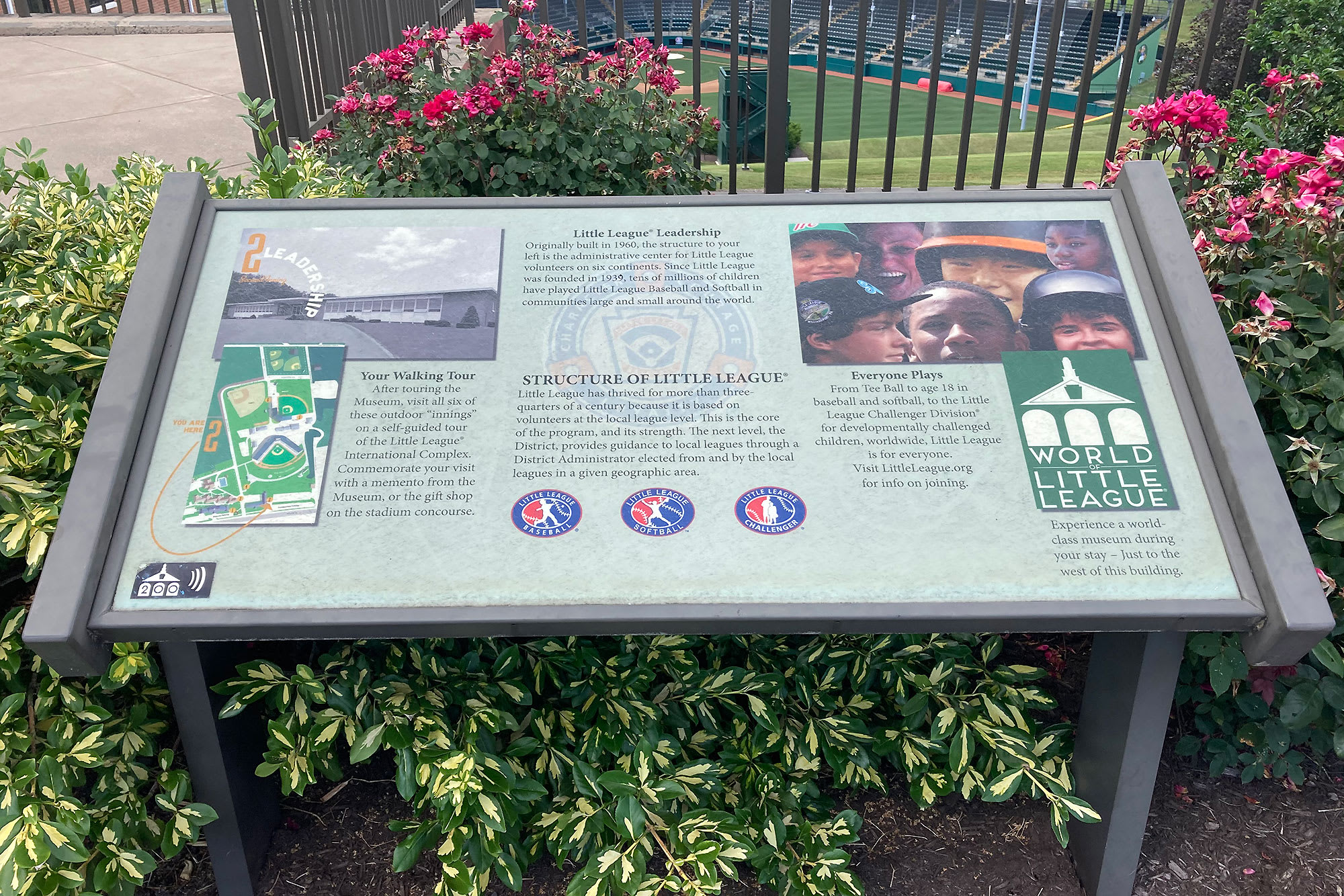
The first part of this building, the wing to the west, was built in 1960. Additions were made over time as the Little League staff grew.
The building is the administrative center, and houses the offices of Little League. It is the workplace for most of the world’s Little League employees.
Operations here are conducted year-around, focused primarily on providing leadership and assistance to local leagues for regular season play. There is one Little League employee in this building for about every 50,000 participants in more than 80 countries around the world.
If you look at one of the pillars near the entrance, you will see a date stone saying 2009. That’s the year that major renovations took place here.
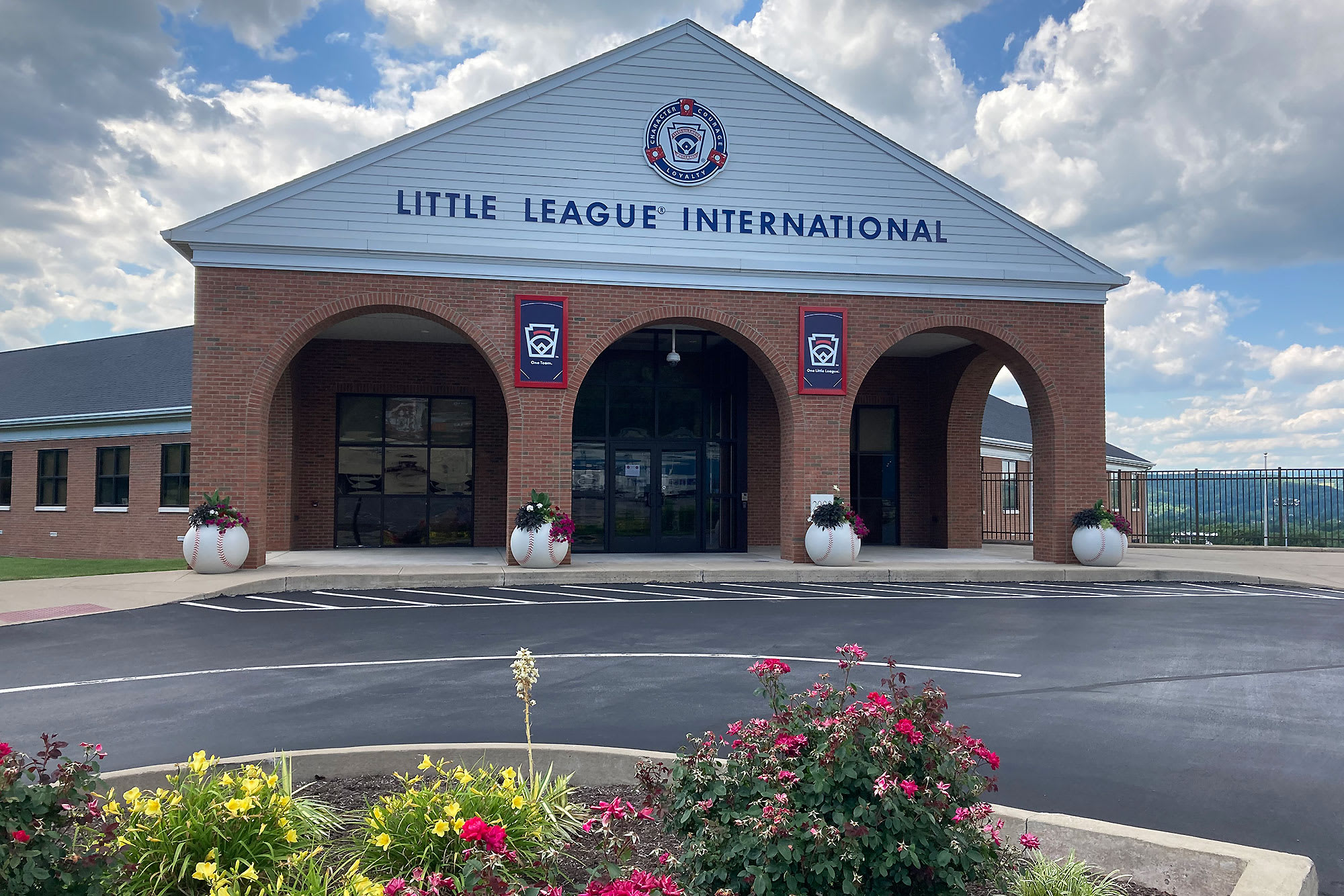
Behind that stone is a time capsule, sealed inside a stainless-steel container, with messages from Little Leaguers around the world. It is scheduled to be opened 50 years after it was placed there, in the year 2059.
Go ahead up to the fence on the patio to get a look at Howard J. Lamade Stadium. You’ll have a chance for an even better photo, however, later in this tour.
Then, go back the way you came, along the sidewalk in front of the Administration Building. But instead of crossing to road to the plaza with the flags, walk downhill about 60 feet – but only if conditions are good for walking downhill.
And remember, if you decide to walk downhill, you’ll probably need to walk back uphill. So, if you’d rather take the rest of the tour in a car, and if the road conditions are good, you might want to ride instead of walk.
THIRD INNING
Dr. Creighton J. Hale International Grove
Audio Player
This area is called the Dr. Creighton J. Hale International Grove. A photo of what the grove looked like back in the 1960s is on the third inning panel.

The Grove is named for the former President and CEO of Little League, who came to the program in the 1950s to do research. That research led to the development of many safety innovations, including the modern radial ribbed batting helmet that is still in use today.
You can learn much more about Dr. Hale and his contributions in the Heritage Gallery of the World of Little League Museum.
The International Grove is where the players, managers, and coaches in the annual Little League Baseball World Series live, eat and sleep while they are here. There are five dormitory buildings, each of which houses four teams.
In the center of the International Grove is the dining and recreation hall. All of the team meals are provided here, and teams use the upstairs area to play video games, ping pong, or to just relax. There’s also a junior-Olympic size swimming pool.
During the World Series, only the teams and a handful of other people are permitted in the International Grove, with no media access. Players can come and go through these gates to meet with families, but this is the place where the teams can just have fun, reaching out and interacting with fellow players from around the world.
The dorms have also been used for Little League Baseball Camps, and for other groups as well. In times of natural disasters, Little League has opened these dorms to families in need.
Now, cross the road, go through the gates, and find the fourth inning panel located near the top of the steps overlooking the stadium.
FOURTH INNING
Howard J. Lamade Stadium
Audio Player
You are standing on the famous hill, overlooking Howard J. Lamade Stadium.
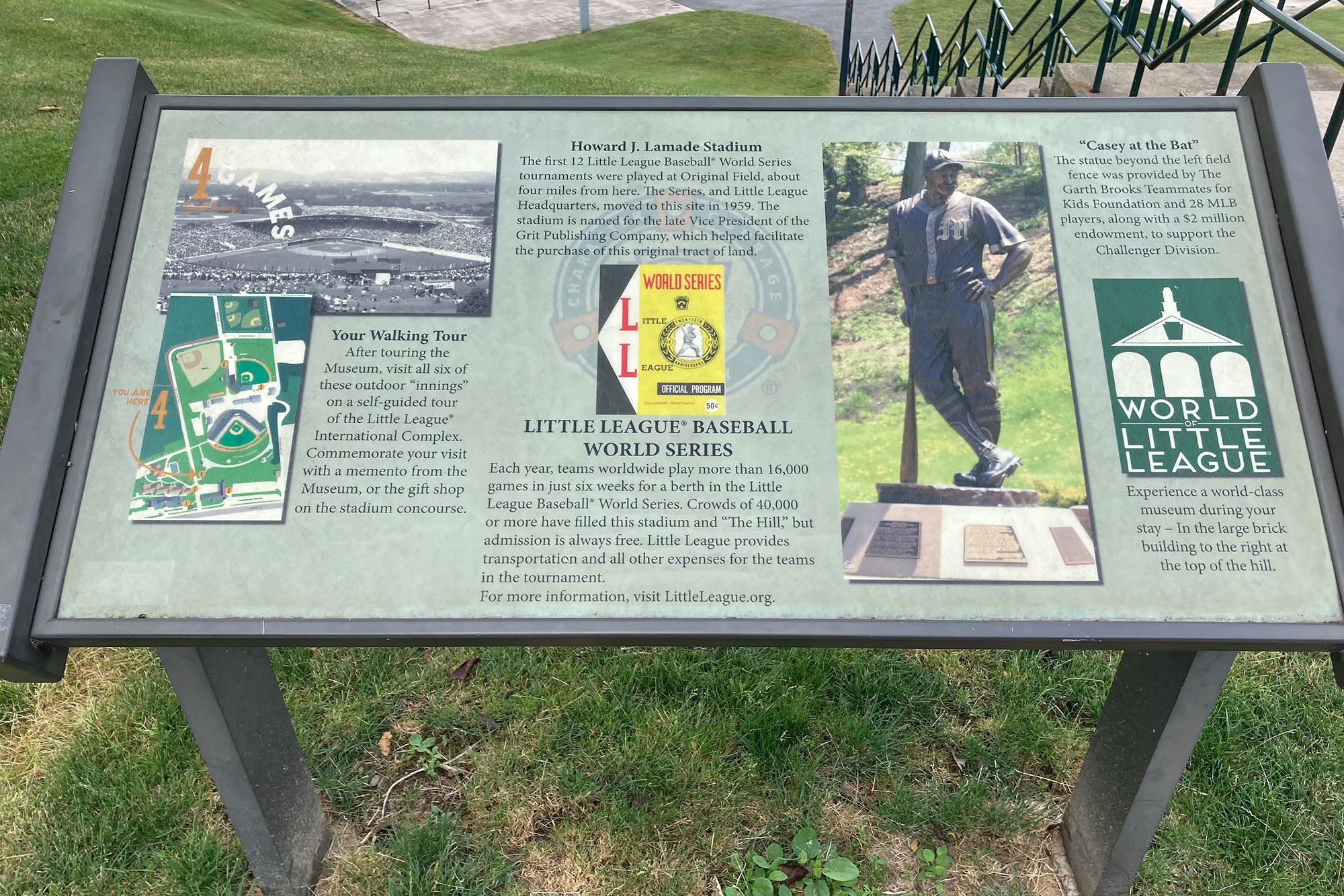
The stadium is named for the late Vice President of the Grit Publishing Company, who was a member of the Little League Board of Directors from 1951 until he passed away later in the decade. You can learn more about Howard J. Lamade, and how this land came to be the site of the Little League Baseball World Series, in the World Series Gallery presented by Easton Foundations, at the World of Little League Museum.
The original stadium was built in 1959 here, and replaced with a concrete stadium in 1968. In its current configuration, the green seats can accommodate about 3,500 people. On this hill, there is no known capacity.
There is never any admission charged to see a World Series game at this facility. In fact, no ticket is even required to sit in the stadium for most games, and tickets are never required for seating on the hill. Free parking also is available.
This stadium and other fields on the complex are used every year for summer camps, by local leagues, and for local tournament play.
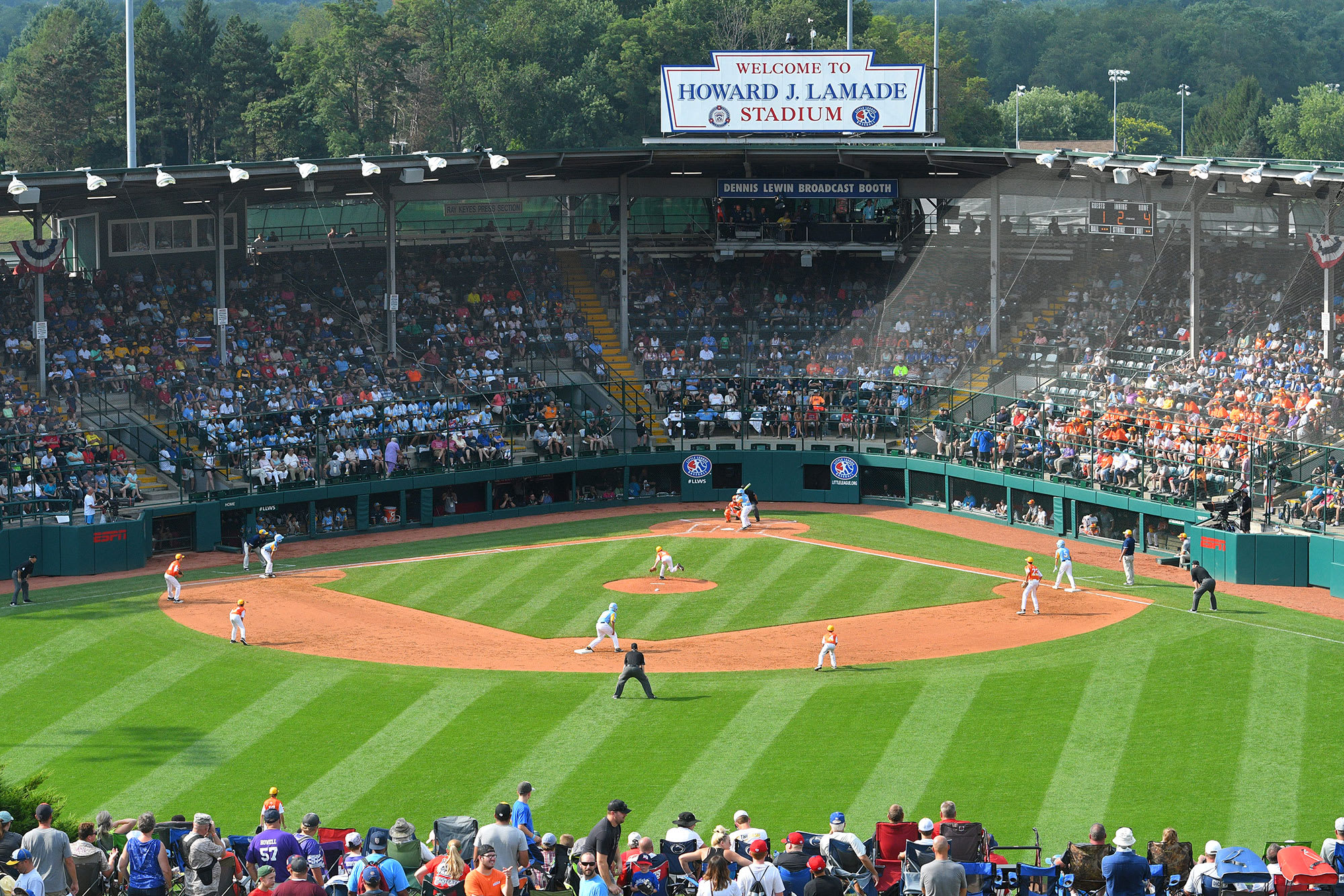
Before you head farther downhill to the fifth inning panel, notice the large sculpture near the scoreboard beyond the left field fence. That’s “The Mighty Casey,” a 14-foot bronze rendition the fabled slugger from the iconic baseball poem “Casey At The Bat,” by Ernest Lawrence Thayer. It is one of four such works in the world, from sculptor Mark Lundeen.
In 2004, the Garth Brooks Teammates for Kids Foundation, together with 28 current and former Major League Baseball players, established an endowment to provide support to the Little League Challenger Division. The sculpture was donated to Little League in recognition of the endowment.
Now, head downhill either by the road, or by the steps, to the fifth inning panel. It’s located just outside Volunteer Stadium, on the first base side.
FIFTH INNING
Volunteer Stadium
Audio Player
This is Little League Volunteer Stadium, dedicated to the millions of adults who have given freely of their time in past decades, who volunteer today, and who will volunteer in the coming years.
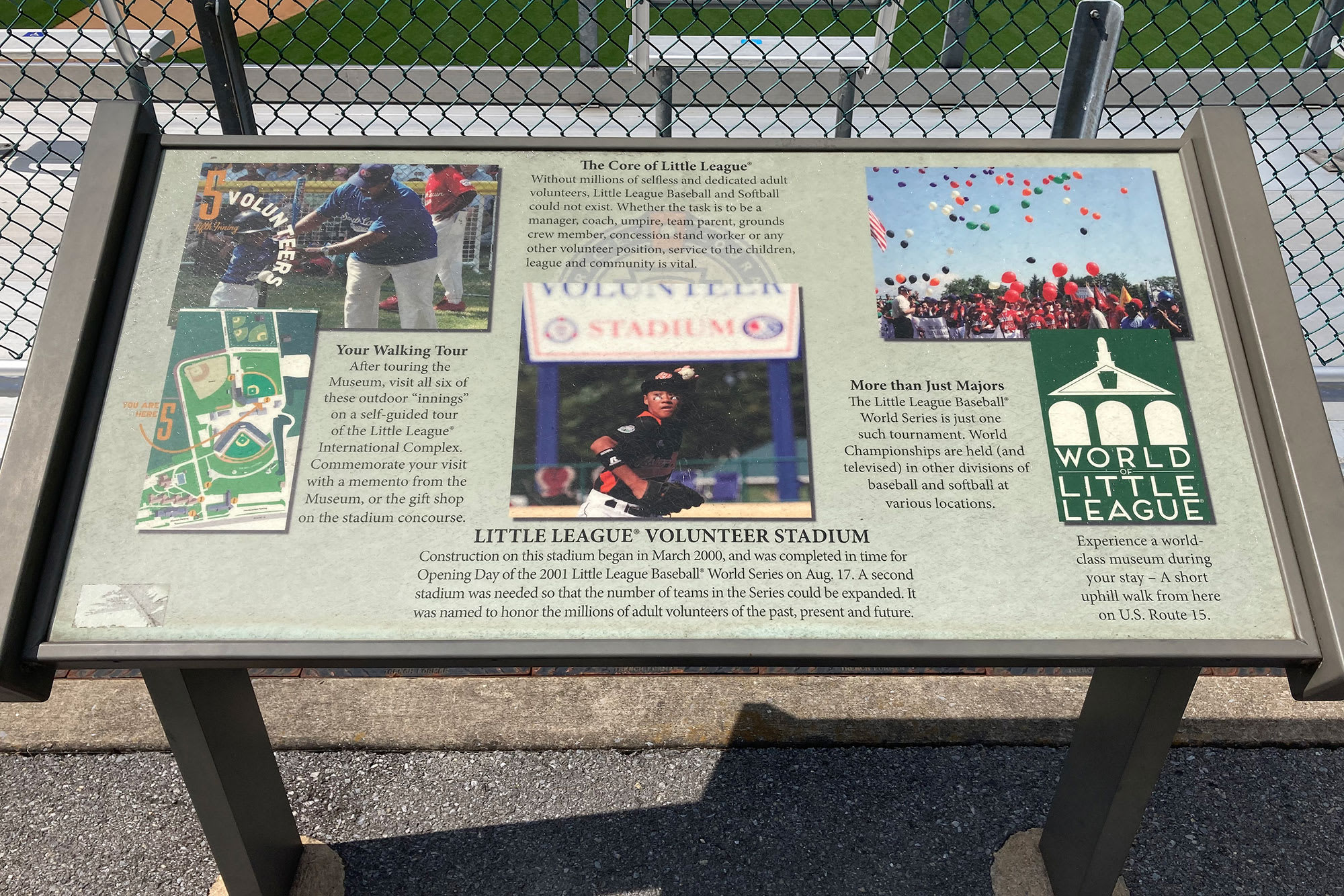
The stadium was opened in 2001, allowing the Little League Baseball World Series to expand from eight teams to 16. Preliminary round games of the World Series are played here, with crowds regularly exceeding the seating capacity of 4,000.
Behind you is the World Series concession stand. As with admission to the World Series, which is free, prices at the concession stand are affordable for families who attend the event.
The area between the two stadiums makes up the concourse. During the World Series, it’s a beehive of activity as fans hustle from one stadium to the other, great smells fill the air, and teams walk to or from the practice fields.

While you’re in this area, make sure you stop by the Stadium Gift Shop. It’s open weekdays from 9 a.m. to 4:30 p.m., unless otherwise noted.
The sixth inning interpretive panel is located outside the third base line of Volunteer Stadium.
SIXTH INNING
Carl E. Stotz Statue
Audio Player
This is the sixth and final inning on your outdoor tour.
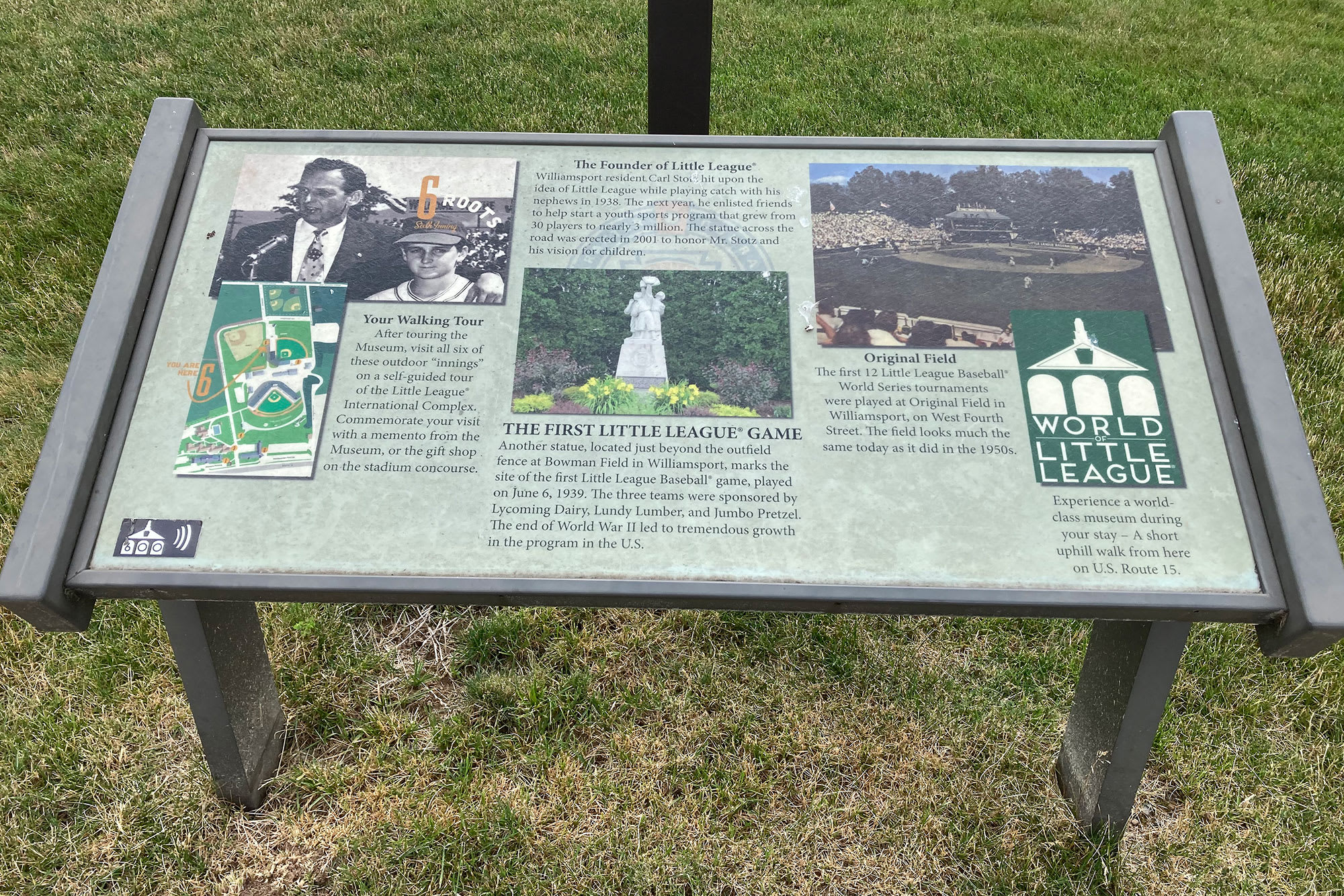
The nearby statue depicts the founder of Little League, Carl Stotz, with a Little Leaguer. It was Mr. Stotz who, in 1938, came up with the idea for the organized youth baseball program that today has players in more than 80 countries around the world. The first Little League game was played on June 6, 1939.
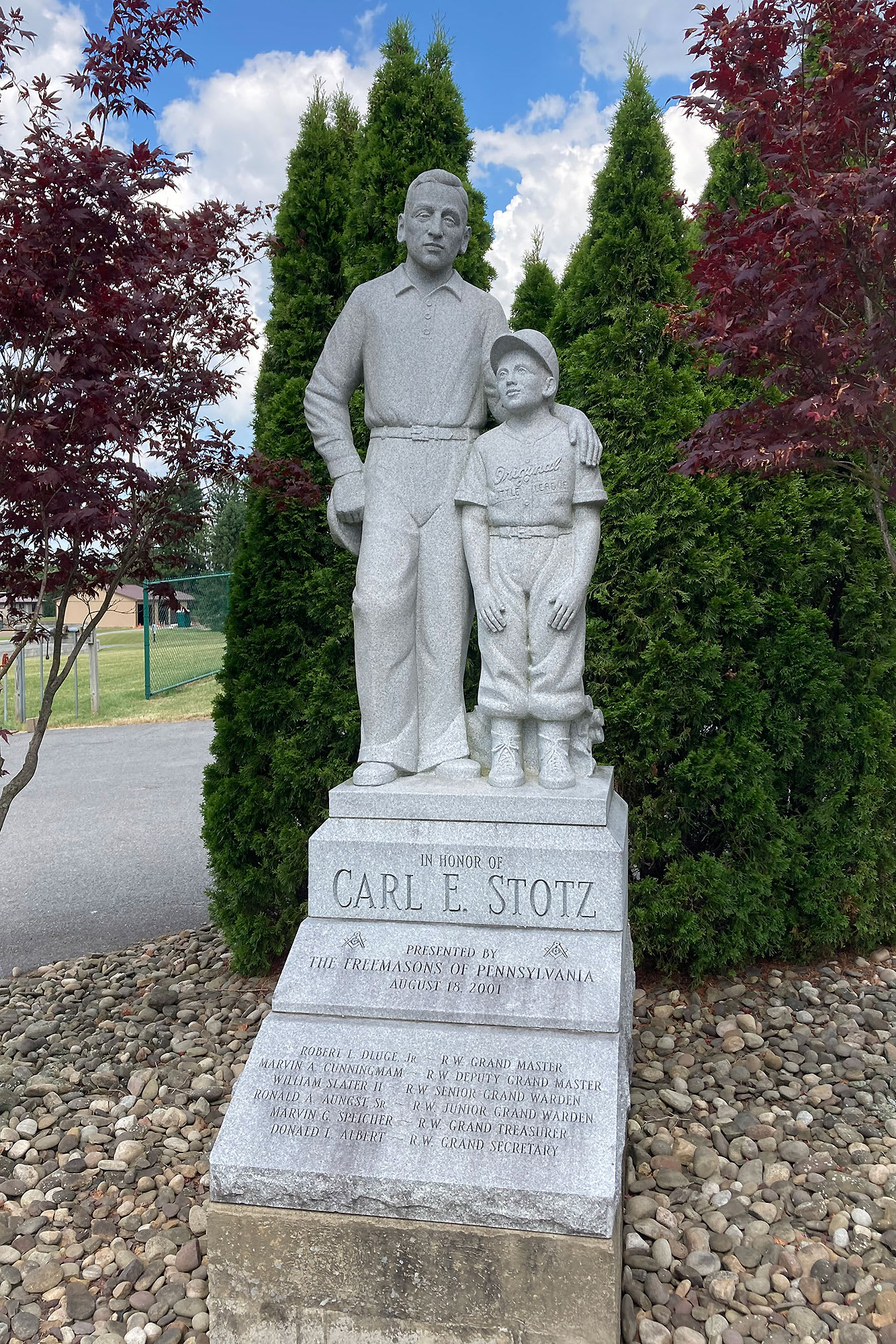
The site of that first game was Park Point in Williamsport, which is now part of the parking lot beyond the outfield Fence at Bowman Field. Another statue there marks the spot where home plate was located.
Nearby is Original Field. That is the site of the first 12 Little League Baseball World Series tournaments, before the series moved to the borough of South Williamsport in 1959.
So, if you would like to further explore the roots of Little League, a visit to Original Field should not be missed.
We hope you have enjoyed your visit to Little League International.
We wish you safe travels, and we hope you can visit again soon!

Visit the World of Little League Museum for more information and shop online by visiting LittleLeagueStore.net.